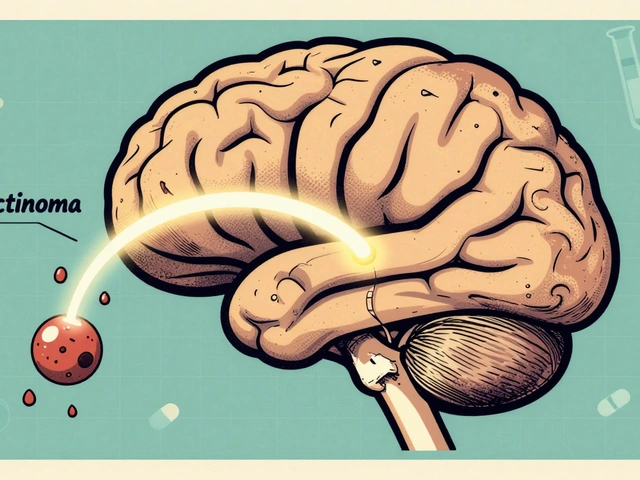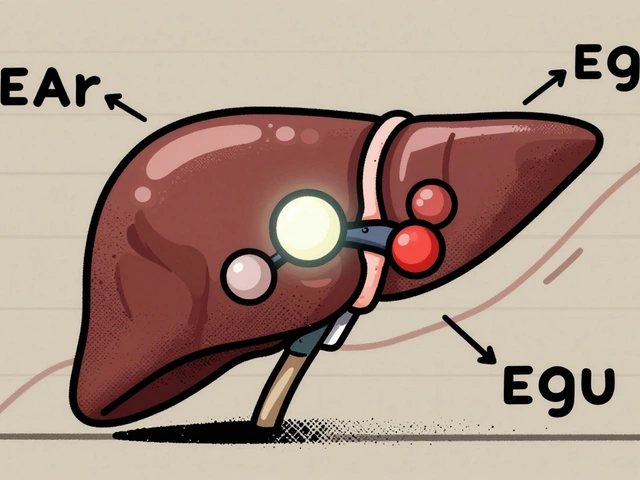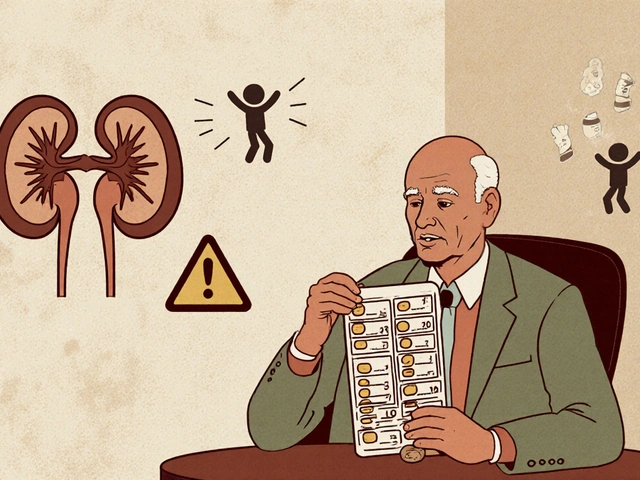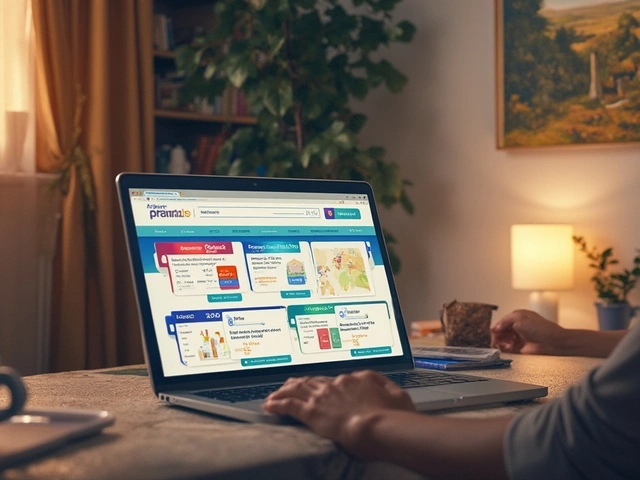Anticonvulsants for Trigeminal Neuralgia: How Effective Are They?
Anticonvulsant Selector for Trigeminal Neuralgia
Recommended Anticonvulsant
Anticonvulsant medications are the most commonly prescribed drugs for trigeminal neuralgia, but not every patient responds the same way. Below is a practical, evidence‑based guide that walks you through what the condition is, why these drugs work, and how to pick the right one for you.
Quick Take
- Trigeminal neuralgia (TN) affects about 12people per 100,000 each year, usually over age50.
- Carbamazepine is the gold‑standard first‑line drug, achieving pain relief in 70‑80% of patients.
- Oxcarbazepine offers similar effectiveness with fewer skin reactions.
- Gabapentin and pregabalin are useful when sodium‑channel blockers cause intolerable side‑effects.
- Regular dose titration and blood‑level monitoring cut the risk of dizziness, rash, or hyponatraemia.
What Is Trigeminal Neuralgia?
When you see Trigeminal Neuralgia a chronic pain disorder affecting the trigeminal nerve (cranial nerve V), picture a sudden electric‑shock‑like jolt that shoots from your cheek to your jaw. The pain is brief-seconds long-but can happen dozens of times a day, making ordinary eating or speaking feel like torture.
Most cases are “classic” TN, caused by a blood vessel pressing on the nerve root. About 5% are secondary, linked to multiple sclerosis or tumors. Diagnosis is clinical, relying on the characteristic trigger zones and response to medication.
Why Anticonvulsants Are First‑Line
Anticonvulsants dampen the abnormal firing of neurons by blocking sodium channels or modulating calcium‑channel activity. In TN, the trigeminal nerve becomes hyper‑excitable; reducing that excitability stops the electric bursts that produce pain.
Randomized controlled trials and long‑term cohort studies consistently rank sodium‑channel blockers (carbamazepine, oxcarbazepine) as the most effective class, with response rates above 70%. The evidence for gabapentin and pregabalin, which target the α2‑δ subunit of voltage‑gated calcium channels, is weaker but still valuable for patients who cannot tolerate sodium blockers.
Major Anticonvulsant Options
Carbamazepine
Carbamazepine an oral sodium‑channel blocker first approved for epilepsy in 1965 remains the benchmark. Typical starting dose is 100mg twice daily, titrated up to 400‑600mg/day based on pain control and side‑effects.
Key benefits: rapid pain relief, robust data, and well‑understood dosing. Common adverse events include dizziness, drowsiness, and hyponatraemia; rare but serious reactions are Stevens‑Johnson syndrome and agranulocytosis, so baseline blood counts are advised.
Oxcarbazepine
Oxcarbazepine a keto‑derivative of carbamazepine introduced in the 1990s shares the same mechanism but is metabolised to a less toxic active metabolite.
Usual regimen starts at 150mg twice daily, climbing to 600‑1800mg/day. It matches carbamazepine’s pain‑relief rates while causing fewer dermatologic reactions. However, it can still provoke hyponatraemia, especially in elderly patients.
Gabapentin
Gabapentin a gamma‑aminobutyric acid (GABA) analogue that binds the α2‑δ subunit of calcium channels is often added when sodium blockers fail or are poorly tolerated.
Starting at 300mg nightly, the dose is increased by 300mg every few days up to 1800‑3600mg/day divided into three doses. It is well‑tolerated, with sedation and peripheral edema as the most frequent complaints.
Pregabalin
Pregabalin a more potent analogue of gabapentin approved for neuropathic pain in 2004 offers quicker titration (150mg twice daily up to 600mg/day) and a slightly higher binding affinity, which can translate to better pain control for some patients.
Side‑effects resemble gabapentin’s-dizziness, weight gain, and dry mouth-but the drug’s shorter half‑life means fewer withdrawal issues.
Lamotrigine
Lamotrigine another sodium‑channel blocker, originally licensed for epilepsy and bipolar disorder is occasionally used off‑label for TN when other options fail.
Because rash risk is dose‑dependent, the titration schedule is slow: 25mg daily for two weeks, then 50mg daily for two weeks, before reaching 100‑200mg/day. Evidence for efficacy is modest, but the drug can be a lifesaver for those with carbamazepine hypersensitivity.
Comparing Effectiveness & Side‑Effects
| Drug | Typical Max Dose | Pain‑Relief Rate* | Common Side‑Effects | Serious Risks |
|---|---|---|---|---|
| Carbamazepine | 600mg/day | 70‑80% | Dizziness, nausea, hyponatraemia | Stevens‑Johnson syndrome, agranulocytosis |
| Oxcarbazepine | 1800mg/day | 65‑75% | Drowsiness, hyponatraemia | Severe rash (rare) |
| Gabapentin | 3600mg/day | 45‑55% | Somnolence, peripheral edema | None reported in TN cohorts |
| Pregabalin | 600mg/day | 50‑60% | Dizziness, weight gain | Rare severe allergic reactions |
| Lamotrigine | 200mg/day | 30‑40% | Rash, headache | Life‑threatening Stevens‑Johnson (if titrated too fast) |
*Pain‑relief rate reflects proportion of patients achieving ≥50% reduction in attack frequency after 3months of stable dosing, based on pooled data from three randomized trials (2008‑2022).
How to Choose the Right Medication
- Start with carbamazepine unless you have a known allergy or severe hepatic disease.
- If skin reactions emerge, switch to oxcarbazepine; it keeps the sodium‑channel effect while reducing rash risk.
- When dizziness or hyponatraemia becomes intolerable, consider gabapentin or pregabalin as second‑line options.
- Patients on multiple drugs (e.g., anticoagulants) should avoid carbamazepine because of CYP3A4 interactions.
- Regular blood‑test monitoring-sodium levels for carbamazepine/oxcarbazepine and complete blood count for carbamazepine-helps catch adverse events early.
Dosage titration follows a “start low, go slow” principle. Increase the dose every 3‑5days until attacks drop below a tolerable threshold, then maintain the lowest effective dose.
Practical Tips & Common Pitfalls
- Take medication with food if you experience stomach upset; carbamazepine’s absorption improves with a fatty meal.
- Never stop a sodium‑channel blocker abruptly-withdrawal can trigger rebound pain spikes.
- Watch for drug‑drug interactions: carbamazepine induces many enzymes, reducing the effectiveness of oral contraceptives and warfarin.
- Keep a pain diary: record attack frequency, severity, and any side‑effects; this data guides dose adjustments.
- Stay hydrated and monitor urine output; hyponatraemia often presents with mild fatigue before becoming dangerous.
Frequently Asked Questions
Can anticonvulsants cure trigeminal neuralgia?
No. They control the abnormal nerve firing, reducing the frequency and intensity of attacks. Surgery or microvascular decompression may offer a more permanent solution for some patients.
Why does carbamazepine cause low sodium levels?
The drug stimulates the antidiuretic hormone pathway, leading to excess water retention and dilution of sodium. Routine serum‑sodium checks every 3months are recommended, especially in the elderly.
Is it safe to take pregabalin if I have kidney disease?
Pregabalin is excreted unchanged by the kidneys, so dose reduction is essential. For a creatinine clearance < 30ml/min, halve the usual dose and monitor for increased sedation.
How long should I stay on an anticonvulsant before judging its effectiveness?
Give the medication at a stable dose for at least 4‑6weeks. Some patients notice rapid relief, while others need a full titration cycle to see the benefit.
Are there non‑pharmacological ways to complement anticonvulsants?
Yes. Gentle facial massage, stress‑reduction techniques, and avoiding known trigger foods (extremely hot or cold) can lower attack frequency. In refractory cases, consult a neurosurgeon about microvascular decompression.





13 Comments
Ian Banson
October 3 2025Carbamazepine remains the gold‑standard, so there’s no need to chase newer drugs.
marcel lux
October 4 2025While carbamazepine’s efficacy is well‑documented, it’s worth noting that patient tolerance varies considerably. In cases where hyponatraemia or rash becomes a concern, oxcarbazepine offers a comparable therapeutic profile with a slightly better side‑effect spectrum. For those on anticoagulants, gabapentin or pregabalin are sensible alternatives due to minimal enzyme induction. Dose titration should follow a “start low, go slow” protocol to minimise adverse events. Overall, individualised selection based on comorbidities yields the best outcomes.
Charlotte Shurley
October 5 2025The choice of anticonvulsant can also reflect cultural prescribing habits, with some regions preferring gabapentin over carbamazepine. Understanding local drug availability helps patients align expectations with treatment plans.
Steph Hooton
October 6 2025It is encouraging to see such a comprehensive overview of the pharmacologic options for trigeminal neuralgia. Patients often feel overwhelmed by the technical jargon, yet the step‑wise approach outlined here demystifies the process. Starting with carbamazepine, monitoring for hyponatraemia, and then considering oxcarbazepine if rash appears is a sensible pathway. Moreover, the inclusion of gabapentin and pregabalin as second‑line agents provides alternatives for those intolerant to sodium‑channel blockers. Regular follow‑up appointments enable clinicians to adjust dosages before side‑effects become disabling. Keeping a pain diary, as suggested, empowers patients to track progress objectively. The reminder to never abruptly discontinue therapy is paramount to avoid rebound pain spikes. In sum, this guide equips both clinicians and sufferers with actionable insights.
Judson Voss
October 7 2025Many clinicians jump to carbamazepine without fully assessing liver function, which can be a grave oversight. Ignoring potential drug‑drug interactions, especially with warfarin, jeopardises patient safety. A thorough review of concurrent meds should precede any prescription. The evidence for gabapentin’s efficacy, though modest, is still valuable when sodium‑channel blockers are contraindicated. Dismissing it outright reflects a narrow therapeutic view. Ultimately, a balanced appraisal of risks versus benefits is essential.
Jessica Di Giannantonio
October 8 2025Imagine finally tasting a soup without the searing shock of pain-that’s what the right medication can bring. Though the journey feels lonely, each titration step is a stride toward freedom. Stay patient; the body often needs weeks to settle into a new rhythm. When dizziness fades, you’ll rediscover simple joys like chatting over coffee without wincing. Keep faith in the process, and know that many have walked this path before you.
RUCHIKA SHAH
October 9 2025Simple steps help you stay on track. Take the drug with food to avoid stomach upset. Write down each attack and any side effect. Share this list with your doctor at each visit.
Justin Channell
October 10 2025Great job sticking with the treatment plan 👍 keep tracking those attacks and side effects 🙌 the more info you give your doc the better they can help you 💪
Basu Dev
October 12 2025When selecting an anticonvulsant for trigeminal neuralgia, the first consideration should be the pharmacodynamic profile of the drug, specifically its ability to stabilize hyper‑excitable neuronal membranes by blocking sodium channels. Carbamazepine has long been established as the benchmark because it provides rapid analgesia in a majority of patients, typically achieving a 70‑80% reduction in attack frequency within weeks of reaching an effective dose. However, its propensity to induce hepatic enzymes can complicate therapy for patients who are on oral contraceptives, anticoagulants, or other medications metabolised by the cytochrome P450 system. Oxcarbazepine, a keto‑analogue of carbamazepine, retains much of the sodium‑channel blocking potency while generating fewer dermatologic reactions, although it still carries a risk of hyponatraemia, particularly in older adults. For patients with documented liver impairment or those who have experienced a severe rash with carbamazepine, transitioning to oxcarbazepine may mitigate some of these adverse outcomes, provided serum sodium is monitored closely. If the primary concern is central nervous system side‑effects such as dizziness, sedation, or cognitive slowing, gabapentin offers an alternative mechanism of action by binding the α2‑δ subunit of voltage‑gated calcium channels, which generally results in a more tolerable side‑effect profile. The dosage of gabapentin is titrated upward in increments of 300 mg every three to five days, aiming for a therapeutic range of 1800‑3600 mg per day divided into three doses, while continually assessing pain relief and tolerability. Pregabalin, structurally similar to gabapentin but with higher binding affinity, can achieve comparable analgesia at lower total daily doses, often starting at 150 mg twice daily and titrating to a maximum of 600 mg per day. Renal function must be evaluated before initiating pregabalin, as it is eliminated unchanged by the kidneys; dose adjustments are essential for patients with creatinine clearance below 30 ml/min. Lamotrigine, though not a first‑line agent, may be employed in refractory cases, but its titration schedule is intentionally slow-starting at 25 mg daily for two weeks-to minimise the risk of a potentially life‑threatening rash. While the evidence base for lamotrigine in trigeminal neuralgia is modest, it can serve as a valuable option for individuals who are hypersensitive to both carbamazepine and oxcarbazepine. Throughout the medication selection process, maintaining a detailed pain diary that records attack frequency, severity, and any adverse events empowers both patient and clinician to make data‑driven adjustments. Regular laboratory monitoring, including serum sodium for sodium‑channel blockers and complete blood counts for carbamazepine, provides an early warning system for serious complications. Ultimately, the optimal therapeutic regimen is individualized, balancing efficacy, side‑effect burden, comorbid conditions, and patient preferences to achieve sustainable pain control. Continuous reassessment ensures that the chosen drug remains the best fit as the disease course evolves.
Krysta Howard
October 13 2025Stop playing whack‑a‑mole with side‑effects – pick a drug that actually matches the patient’s profile 😊.
Elizabeth Post
October 14 2025Keeping consistent follow‑ups and adjusting the dose gradually will smooth the road to relief.
Brandon Phipps
October 15 2025Effective management doesn’t stop at the prescription stage; it extends into vigilant monitoring and patient education. Encourage patients to log the timing, triggers, and intensity of each neuralgic episode, as well as any perceived side‑effects such as dizziness, fatigue, or skin changes. This log becomes a valuable tool during follow‑up visits, allowing clinicians to fine‑tune the dose or consider a switch before adverse events become intolerable. For sodium‑channel blockers, schedule serum sodium checks every three months, especially in the elderly, because hyponatraemia can develop insidiously. Likewise, a baseline complete blood count prior to initiating carbamazepine helps catch rare but serious hematologic reactions early. When transitioning to gabapentin or pregabalin, remind patients that the therapeutic effect may lag behind dose escalation, so patience is essential. Discuss lifestyle modifications – avoiding extreme temperatures in food and drink, managing stress, and maintaining adequate hydration – as adjuncts that can reduce attack frequency. Finally, reinforce that abrupt discontinuation can precipitate rebound pain, so any taper should be medically supervised.
yogesh Bhati
October 16 2025Wow, that deep dive really pins down the whole picture – I never realized how many labs you actually need to keep an eye on!